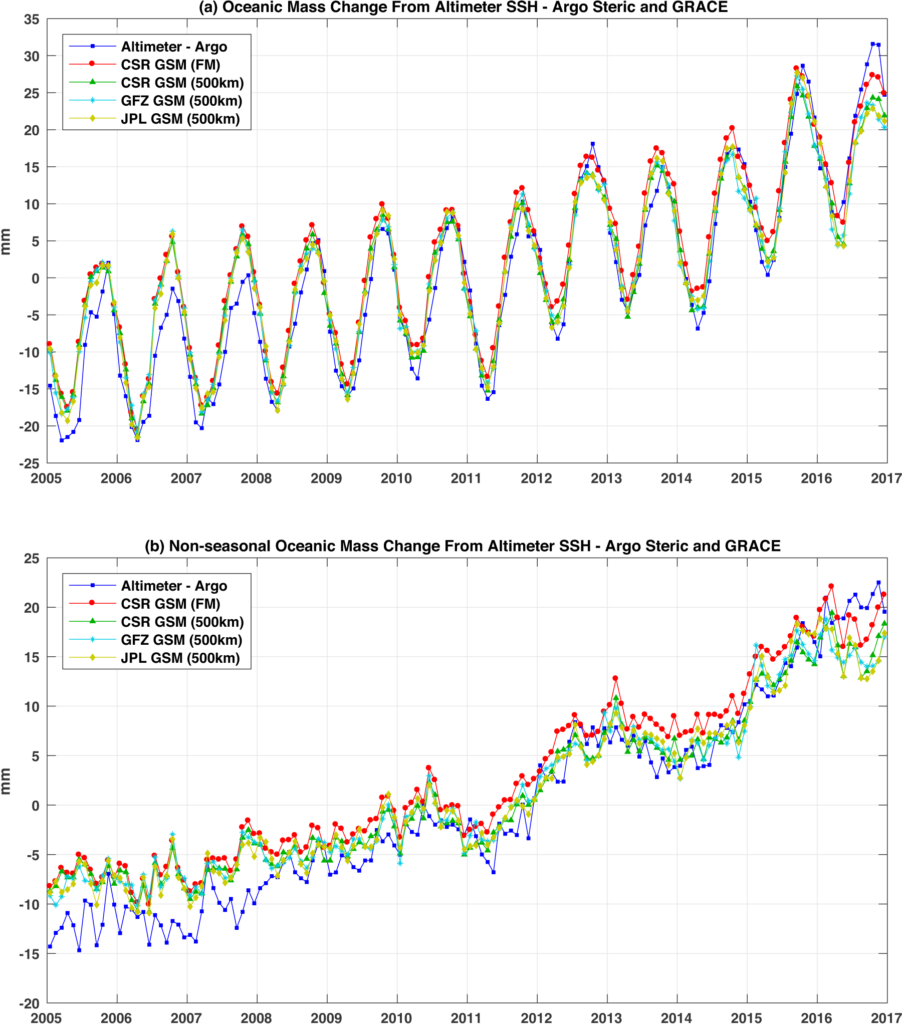Quantification of Ocean Mass Change Using GRACE Gravity, Satellite Altimeter and Argo Floats Observations, November 13, 2018, Dr. Jianli Chen and a group of scientists at the Center for Space Research are the authors of a study published in the Journal of Geophysical Research -Solid Earth. Combining satellite gravity measurements from the Gravity Recovery and Climate Experiment (GRACE), sea surface height anomalies from satellite altimeter, and ocean temperature and salinity observations from the Argo floats network has brought a new era to the studies of the global sea level change, in particular the quantification of different contributions to the global mean sea level change, which include ocean mass change due to water exchange between the ocean and other components of the Earth, and sea water density change due to ocean temperature and salinity change.
Dr. Chen and his colleagues analyze global mean ocean mass (GMOM) change over the 12?year period (January 2005 to December 2016) using three different Gravity Recovery and Climate Experiment (GRACE) RL05 monthly time-variable gravity solutions and compare GRACE results with independent observations from satellite altimeter and Argo floats (i.e., Altimeter?Argo). The new results from both GRACE and Altimeter?Argo show substantially larger GMOM rates than previous estimates, attributed to increased ice losses over land in recent years. Altimeter measurements show an average sea level rise rate of 3.87 ±0.16 mm/year over the 12?year period, with 1.12 ±0.08 mm/year driven by steric effect based on Argo observations. GRACE?observed ocean mass change agrees well with Altimeter?Argo estimates at seasonal time scales, but notable discrepancies exist at long?term time scales. GRACE?estimated GMOM rates, ranging from 2.17 ±0.12 to 2.39 ±0.12 mm/year, are notably smaller than the Altimeter?Argo estimate of 2.75 ±0.18 mm/year. However, when GRACE degree?2 zonal terms are retained (instead of being replaced by satellite laser ranging measurements), the forward modeled GRACE GMOM rate is 2.70 ±0.16 mm/year, consistent with the Altimeter?Argo estimate.
Accurate quantification of GMOM change using GRACE is challenging and relies on accurate correction for contributions from geocenter motion and Earth oblateness change using independent observations and the Glacial Isostatic Adjustment effect using model predictions. Their analysis indicates that long?term geocenter motion alone may contribute ~0.3 mm/year to GRACE GMOM rates, and different data processing methods have notable effect on GRACE GMOM estimates.

The paper is available for downloading at https://agupubs.onlinelibrary.wiley.com/doi/abs/10.1029/2018JB016095 [https://doi.org/10.1029/2018JB016095].
